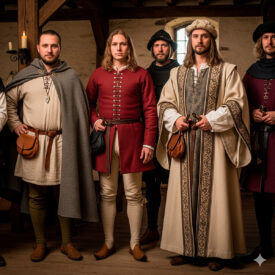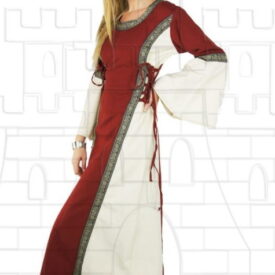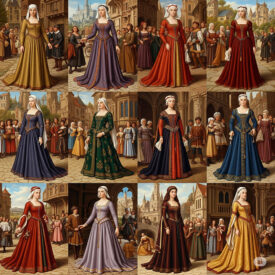What lies behind a monk costume? Why does a simple tunic arouse so much respect and curiosity? The habit is not a fashion: it is a visible testimony of a life choice. In this article we will explore its history, functions, variations by orders and traditions —Christian and Buddhist— and how they adapt today without losing their essence. You will learn to identify the symbols, understand their colors and recognize the elements that distinguish each community.
The sacred mantle: a journey through the visible signs of monastic life
At first glance, a religious habit may seem simply an article of clothing. However, for those who have chosen a spiritual path, this garment is much more: it is a deep symbol of commitment, identity and way of life. Across the centuries and in different cultures, the habit has served as an outward manifestation of an inner reality.
The term habit has a double meaning: it refers both to a behavior acquired by repetition and to the religious clothing that marks a state of life. For a religious person, these two senses are connected: the outer habit reflects an inner habit cultivated through prayer, work and discipline.
Why wear the habit? A symbol with purpose
The decision to wear a habit is neither trivial nor merely aesthetic. Its main meanings are clear and direct:
- Renunciation and detachment: it symbolizes the abandonment of worldly possessions and the preference for communal life and prayer.
- Identity and belonging: it indicates affiliation to a specific order and daily reminds one of the commitment made.
- Vow of poverty: it helps maintain coherence with the vow lived: fewer changes of clothes, less attachment, greater mobility for service.
- Public witness: it turns the religious person into a visible sign of spiritual and moral presence in society.
Although it is popularly said that “the habit does not make the monk”, the habit acts as a reminder and a tool to sustain the inner life that the person cultivates.
The clothing that speaks: the purpose of the monastic habit
At its deepest root, the habit is a declaration: renounce vanities, diminish the self and serve. Its forms originate in the civilian dress of the first Christians, later simplified by those who chose asceticism. This simplification was practical and symbolic — fewer pieces meant fewer material concerns.
Traditionally, a typical Christian habit includes a long tunic (often wool), a scapular, a hood and a belt or cord. Each of these elements has a symbolic and practical function: to shelter, distinguish and bind life to the spiritual commitment.

Christian dress: tradition and diversity
The Christian world is a mosaic of orders and charisms, and that diversity is clearly reflected in their habits. Colors, cuts and accessories tell the story of each order: its origin, spirituality and mission. Below we review the most representative orders and their distinctive features.
The Benedictines: founders of Western monasticism
Saint Benedict of Nursia laid the foundations of monastic life in the West with his Rule, which balanced prayer, work and study. The Benedictine habit — sometimes called a cowl or colobium — is wide, with long sleeves and a hood, designed for the comfort of work and contemplation. Traditionally dark in color (often black), it symbolizes death to the world and dedication to God.
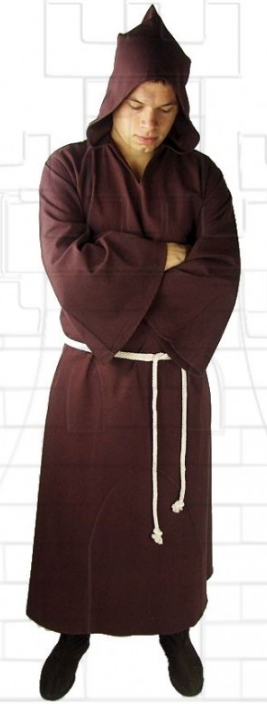
The practical design allows monastic tasks to be carried out while maintaining a sober presence during the Liturgy of the Hours and community life.
The Franciscans: humility in earthy tones
The Franciscan image is immediate: a tunic with a hood and a woolen cord. Saint Francis and his first companions dressed very simply, with undyed wool that produced ashy tones. The original habit evoked a cross or a tau, emphasizing radical poverty and identification with the poor.
Over time variations emerged: ashen gray, russet (reddish) and finally the brown we now associate with the order. Franciscan branches show differences: the Conventuals adopted black in the 18th century, the Observants switched to brown and the Capuchins keep a longer hood, closer to the original design.
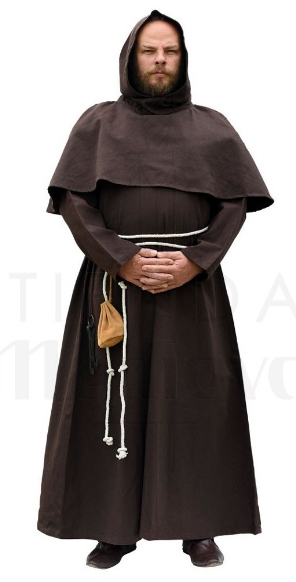
A universal distinctive is the cord with three knots symbolizing the vows of poverty, chastity and obedience. Although walking barefoot was emblematic, safety and climate required sandals or simple footwear.
The Cistercians: white monks of austerity
The Cistercians, born as a Benedictine reform, became known as “white monks” for their light tunic with a dark scapular. Their choice sought maximum simplicity: a life of manual work, careful liturgy and austere architecture that encouraged contemplation without distractions.
Their presence was key in medieval technical innovation, but their spiritual ideal remained centered on purity and sobriety: their habit reflects that choice.
The Dominicans: preachers in white
The Order of Preachers (Dominicans) is identifiable by its white habit. This color conveys purity and truth, central traits of their preaching mission. They are often recognized by the belt and the rosary hanging from the waist, a symbol of their apostolic and Marian tradition.
Seeing a Dominican on the street is often regarded as a sign of joyful and apostolic presence: their habit speaks of their calling to preach and to study.
The Augustinians: unity and sobriety
The Augustinians wear a tunic or habit traditionally black, girded by a black leather belt. Over it one can see a cape or shoulder cape. In warm climates the use of a white habit with a black belt is permitted. Augustinian nuns follow similar schemes, with coif and veil according to their stage of profession.
Their ideal —”one soul and one heart turned to God”— is reflected in the visual unity of the habit and in the symbols that often complement the garment (book, heart on their coat of arms).
The Carmelites: the color of contemplation
Born on Mount Carmel, the Carmelites are associated with the chestnut color. Their spirituality centered on contemplative prayer and Marian devotion is reflected in a sober habit that distinguishes friars, cloistered nuns and lay Carmelites alike.
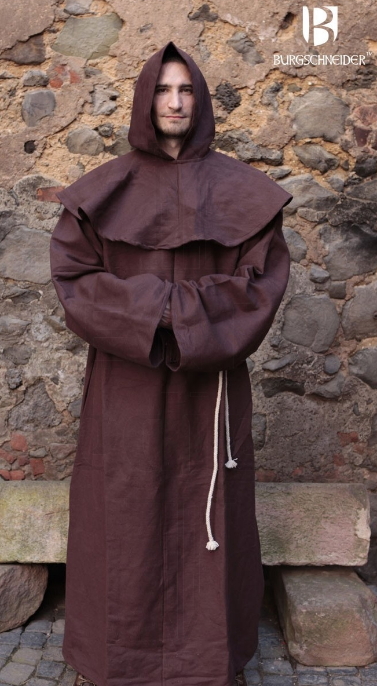
Other Christian habits: a rainbow of devotion
Beyond the orders already described, there are many variations: Dominicans and Carthusians in white, Servites, Mercedarians, Trinitarians and others with habits that reflect their charism and mission. Among nuns, the veil, coif and wimple distinguish novices from professed sisters and help maintain community identity.
The Secular Franciscan Order (OFS) and the laity
Secular Franciscans live Franciscan spirituality without full religious life, so the Rule does not favor the public use of the habit. Instead, they use discreet symbols such as the Tau or a cross of Saint Damian; only on specific occasions and according to national statutes may a differentiated uniform be authorized.
Buddhist dress: symbolism and practice in the East
Buddhist garments are equally rich in meaning. The saffron robe, present in many Southeast Asian traditions, represents simplicity, renunciation and purity. As in Christianity, clothing serves as an outward manifestation of an inner life dedicated to the Dharma.
The saffron color and the three essential pieces
The traditional Buddhist habit consists of three pieces or “tricivara”:
- Antaravasaka: the lower garment, similar to a pareo.
- Uttarasanga: the main piece that covers from shoulder to ankle.
- Sanghati: a thicker outer garment for ceremonies and cold weather.
Monks usually wear simple sandals or walk barefoot. The shaved head and the alms bowl are signs of humility and availability for service.
Details in the Tibetan tradition
In Tibet and Mahayana traditions the tones shift to reds and yellows. Garments such as the Choegu, the Namjar or the Shemdap have specific uses and symbolism, and the folds of the robes indicate levels of ordination and teachings.
Beyond appearance: materials and function
Aside from its symbolic load, habits fulfill practical functions: they protect from the weather, allow manual work and facilitate community life. Traditionally materials such as wool and undyed cotton were used for their durability and availability.
In Buddhism, the use of patches sewn into several pieces emphasizes poverty and detachment. In medieval Europe, these principles led to creative use of resources; today many orders still prefer simple, durable materials.
Modern adaptation has not erased the original meaning: there are practical solutions (cardigans, vests, liners) that integrate with the habit without altering its significance. This allows religious men and women to move in different climates and carry out social work while maintaining decorum and coherence.
The habit remains a language: every fold and every color communicates a story of vocation. From the humble gray of the first Franciscans to the saffron of Southeast Asia, each order tells its choice for the essential. If you are interested in acquiring replicas or garments inspired by these traditions, you can do so in our online store, where we offer a selection of monk costumes and historical accessories for events and reenactments.
The habit is not just fabric: it is a visible commitment. When you observe it, you are seeing centuries of tradition, vows lived and a call to simplicity. That call endures and invites us to reflect on the value of decisions that are seen and those lived in silence.
SEE MONK COSTUMES | SEE MEDIEVAL-STYLE COSTUMES | SEE ACCESSORIES FOR MEDIEVAL CLOTHING


